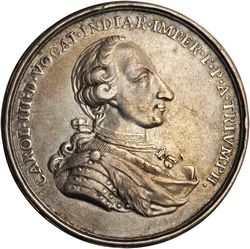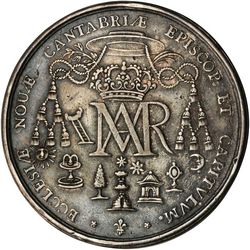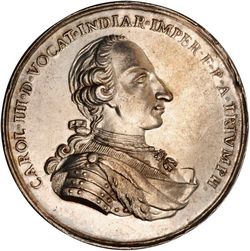Charles III Proclamation medals
Charles III was King of Spain from 1759 to 1788
Mexico City
One of the first medals on which the engraver's name appears is the proclamation medal designed by the Spaniard Alejo Bernabé Madero in 1760 and minted in silver. On the obverse, the monarch is seen in right profile wearing the collar of the Order of the Golden Fleece, surrounded by the abbreviated legend in Latin: "Charles III by the grace of God King of Spain". It also reads: "Mexico Proclamation 1760." On the reverse is the coat of arms of Mexico City adorned with leaves and flowers; On the perimeter is the abbreviated Latin legend: "Testimony of fidelity and public joy." This medal is much better achieved than the previous ones, dedicated to Philip V and Louis I.

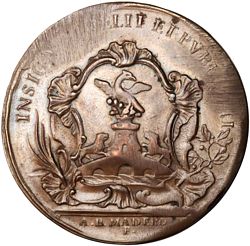
K-1b Bronze Proclamation Medal (Stack’s Bowers NYINC Auction, January 2015, lot 1014)
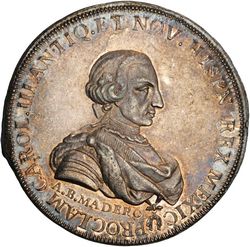
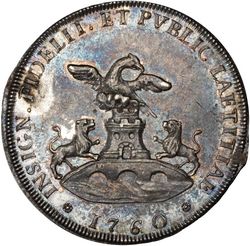
K-2v Silver Proclamation Medal (Stack’s Bowers NYINC Auction, January 2015, lot 1015)
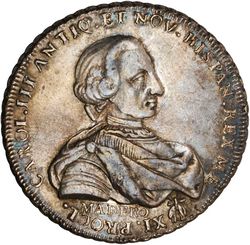

K-3 Silver Proclamation Medal (Stack’s Bowers NYINC Auction, January 2015, lot 1016)
El Arzobispo
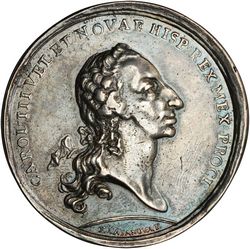
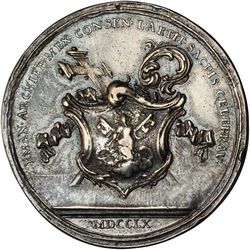
K-5 Silver Proclamation Medal (Stack’s Bowers NYINC Auction, January 2015, lot 1017)
This has the arms of the Archbishop on the reverse. It was designed by Francisco Casanova.
El Consulado
The history of the Consulado is detailed here.
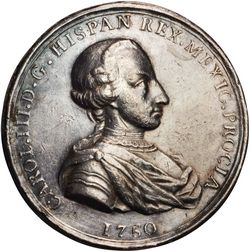
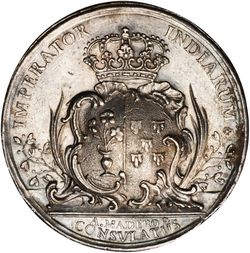
K-6v El Consulado Silver Proclamation Medal (Stack’s Bowers NYINC Auction, January 2015, lot 1018)
This medal was engraved by Alejo Bernabé Madero. It has the same dies as Grove K-6 but with the edge lettering of K-7v.
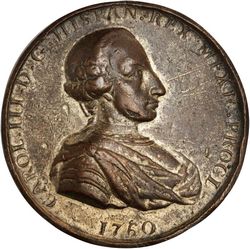

K-7b El Consulado Bronze Proclamation Medal (Stack’s Bowers NYINC Auction, January 2015, lot 1019)
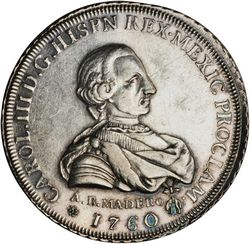

K-8 El Consulado Silver Proclamation Medal (Stack’s Bowers NYINC Auction, January 2015, lot 1020)
La Universidad
The rector of the University, Manuel Ignacio Beye de Cisneros, vowed on 25 September 1761 that the university was a loyal vassal to the new King. This was consummated with a medal to commemorate such a joyous day.
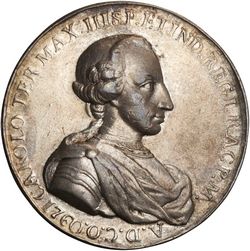
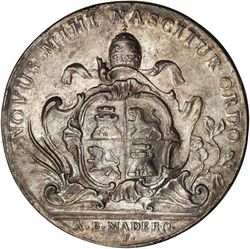
K-11a La Universidad Silver Proclamation Medal (Stack’s Bowers NYINC Auction, January 2015, lot 1022)
This was designed by Alejo Bernabé Madero and has the arms of the Royal Mexican Pontifical Academy on the reverse.


K-78a Bronze Medal (Stack’s Bowers NYINC auction, January 2015, lot 1037)
This medal, celebrating the birth of Prince Ferdinand, was designed by Gerónimo Antonio Gil. The obverse has the bust of the king right, facing conjoined busts of Charles (later Charles IV) and Maria Louisa. The reverse has an armored draped personification of Spain standing at left, fire altar, shield and rabbit behind, handing infant to kneeling draped personification of Mexico (New Spain), with shield behind and cornucopia at feet.
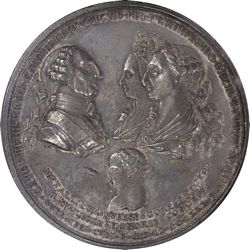
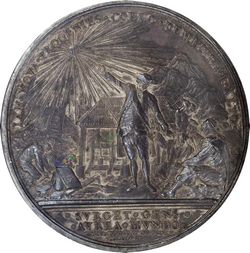
K-82a Silver Proclamation 8 Reales (Stack’s Bowers Auction, 27 February 2020, lot 71211)
This medal, also celebrating the birth of Prince Ferdinand, was designed by Gerónimo Antonio Gil. The obverse has the bust of the king right, facing conjoined busts of Charles (later Charles IV) and Maria Louisa with the infant Prince below. The reverse has miners working near mine entrance as the rays of the sun illuminate the scene.
Cordoba
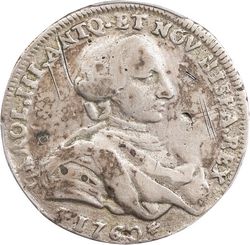
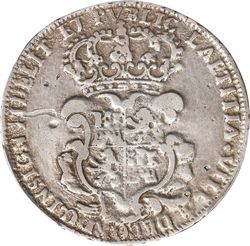
K-17 Silver Proclamation Medal (Stack’s Bowers NYINC Auction, 18 January 2024, lot 57549)
The obverse has the garlanded, draped, and armored bust of the king whilst the reverse has the crowned and garnished coat-of-arms of Spain.
Durango (Nueva Cantabria)
K-19 Silver Proclamation Medal (Stack’s Bowers NYINC Auction, January 2015, lot 1023)
This has the armored draped bust of Charles III on the obverse and the crowned monogram of the Virgin Mary with cardinal’s hat above on the reverse. It was struck from the same obverse die as the 1761 Guanajuato medal (Grove K-28).
Guadalajara
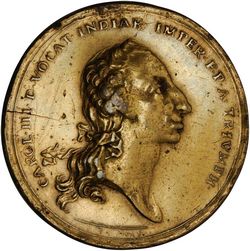
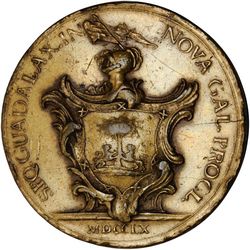
K-24a (but gilt) Gilt Bronze Proclamation Medal (Stack’s Bowers NYINC Auction, January 2015, lot 1024)
La Audiencia
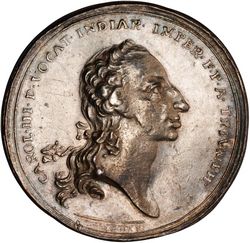
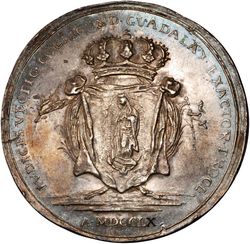
K-25 La Audiencia Silver Proclamation Medal (Stack’s Bowers NYINC Auction, January 2015, lot 1025)
Most references (including Grove) were unable to locate an image of this medal, simply reprinting the line drawing from Herrera. On the reverse are rms comprised of a crowned and draped Virgin of Guadalupe, with the date below in Latin numerals the final one of which has been hand engraved.
El Obispo
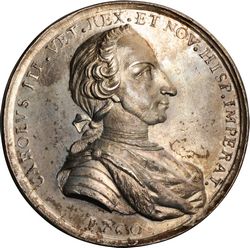

K-26 El Obispo Silver Proclamation Medal (Stack’s Bowers NYINC Auction, January 2015, lot 1026)
This medal, designed by Alejo Bernabé Madero, was commissioned by the bishop Francisco de San Buenaventura Martinez de Tejada who paid for the medals’ production.
Guanajuato
K-28 Silver Proclamation Medal (Stack’s Bowers NYINC Auction, January 2015, lot 1027)
This same obverse die was used to strike the Durango (Nueva Cantabria) medal (Grove K-19).
Oaxaca

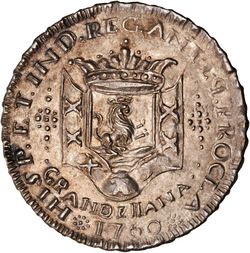
K-40 Silver Proclamation Medal (Stack’s Bowers NYINC Auction, January 2015, lot 1029)
A very interesting stuck medal that is clearly of local manufacture. Most likely produced by a local silversmith who designed this portrait style based on using the 1760 Mexican portrait gold coinage of Charles III as his model. Some catalogers have speculated the silversmiths name could be "Grandellana", as this name appears below the local arms on the reverse. A very neatly applied laurel edge has been applied (possibly by hand).
Pachuca y Real del Monte
The vows ceremony took place on 19 April 1761 by José María de la Canal.

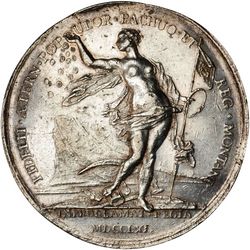
K-41a Silver Proclamation Medal (Stack’s Bowers NYINC Auction, January 2015, lot 1028)
This medal was designed by Francisco CasanovaBorn in Zamora, Spain, in 1734. Casanova studied at the Royal Academy of Fine Arts of San Fernando in Madrid and, due to his great talent, was appointed director of engraving at the Mexican Mint.. On the reverse is a standing draped figure of Diana with head to left, proclamation medals falling from her raised hand and a flag on spear and ouroboros in her other, with a mountain in the background.
San Miguel el Grande
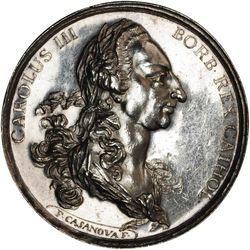
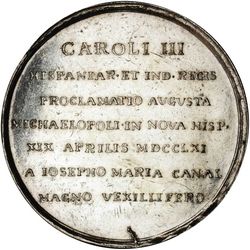
K-52 Silver Proclamation Medal (Stack’s Bowers NYINC Auction, January 2015, lot 1030)
Designed by F. Casanova. The reverse of the medal actually gives the date of the proclamation ceremonies as 19 April 1761.
[image needed]
Another medal designed by Francisco Casanova, On the obverse appears the bust of the king in right profile and with abundant hair. The legend on the perimeter reads in Latin: "Charles III Bourbon Catholic King". The reverse depicts the figure of the goddess Diana with a banner in her raised right hand. The legend reads abbreviated and in Latin: "Charles III, King of Spain and the Indies, the city of San Miguel in New Spain for his august proclamation dated April 19, 1761."
Tabasco
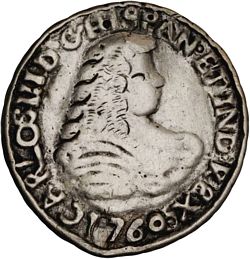
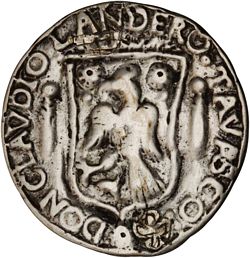
K-54 Cast and Chased Silver Proclamation Medal (Stack’s Bowers NYINC Auction, January 2015, lot 1031)
A very interesting medal that is clearly of local manufacture. It is likely the local artist designed this medal using the portrait from the gold coinage of Ferdinand VI as his reference model. Hand applied edge done with a small circular punch repeatedly, creating a very crude rendition of colonial edging. A very interesting medal that leads to some speculation. First and foremost, the portrait is that of Ferdinand VI, rather than Charles III. Secondly, the style of the king’s name appears to be of a more debased style or different font than that of the remainder of the legends. Although no Ferdinand VI medals are known for Tabasco, or of this portrait style in genera, it is suspected that the proto mold for this medal was probably produced from an earlier medal of Ferdinand VI which is no longer known to exist. The crude nature of the casting would also support this, suggesting the "madre" or "mother coin" used to produce this mold was also cast.
Valladolid
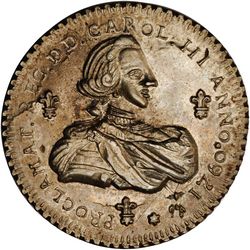

K-62 Silver Proclamation Medal (Stack’s Bowers NYINC Auction, January 2015, lot 1032)
Undoubtedly, this medal was produced locally in Valladolid by a skilled silversmith. The portrait of Charles III was clearly designed using a 1760 Mexican 8 Escudos as the artist’s reference model. The reverse legend on this medal has a unique feature as it actually cites the date of the oath swearing ceremony (24: NOVENB.). Medina states that the oath swearing ceremonies commences on 24 November and that during this event, Jose Maria de Lira is said to have thrown said medals to the crowd. It is interesting to note that edge milling machinery was actually used in the production of this medal (even though no mint was located in this city). The medal features a very neatly and deeply executed edge milling, in somewhat of a diagonal cross stitch pattern that is unique to this medal.
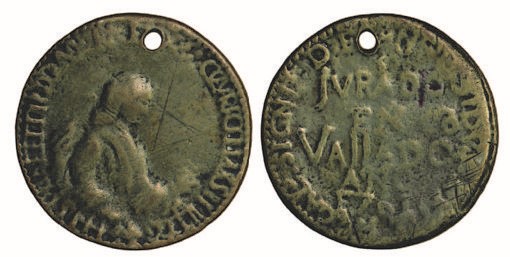
For information on the ceremonies in Valladolid and on these two medals see here.
Veracruz
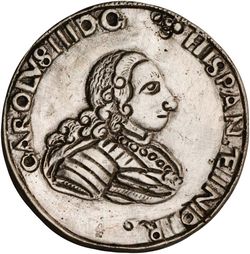
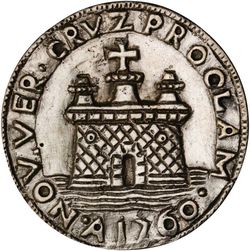
K-66 Cast and Chased Silver Proclamation Medal (Stack’s Bowers NYINC Auction, January 2015, lot 1033)
This medal is clearly modeled after the earlier Veracruz medals of Louis I and Ferdinand VI. While the overall quality of the cast is quite good, although well detailed this medal was clearly chased by a less skilled artist than that of the previous two kings.

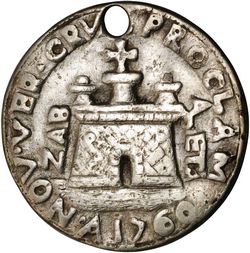
K-67 Cast and Chased Silver Proclamation Medal (Stack’s Bowers NYINC auction, January 2015, lot 1035)
This medal has a crude armored bust of Charles III and, on the reverse, the arms of Veracruz. The mold for casting was made by altering the 1760 Veracruz above (Grove-K-66) with the addition of "ZAB ALETA" flanking the castle on the reverse.
Xalapa
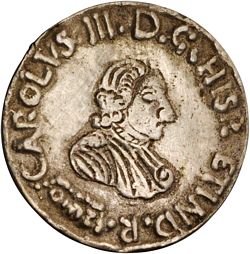

K-39v. Cast and Chased Silver Proclamation Medal (Stack’s Bowers NYINC auction, January 2015, lot 1034)
This medal has the armored bust of Charles III on the obverse and the crowned arms of Spain on the reverse. Although similar to Grove K-39 the medal here deviates in size and legend placement. The obverse legend features abbreviated spellings of "HISPAN", and "REX". It is likely that the reverse mold was produced using a modified pillar 2 Reales. Grove states the initials "D.L.R." present on the reverse is an abbreviation for "de la Feria".

